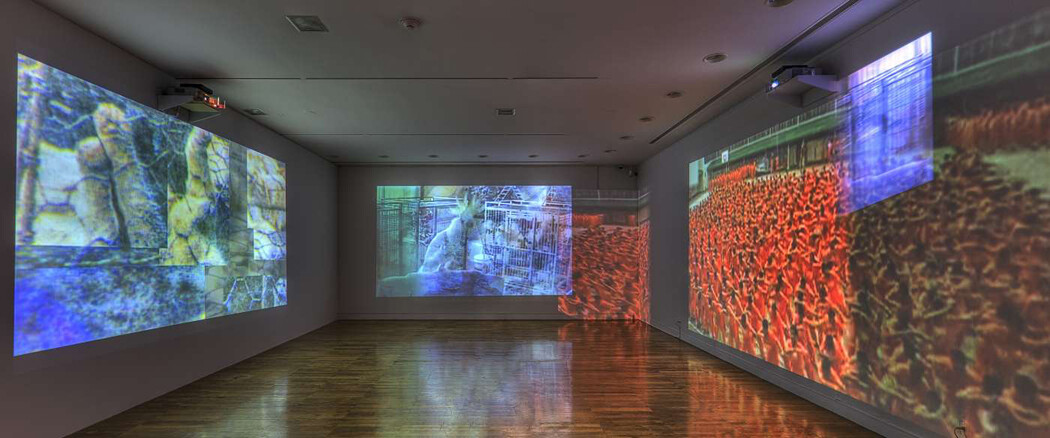June 24–September 3, 2017
76 allées Charles de Fitte
Les Abattoirs, Musée - Frac Occitanie Toulouse
31300 Toulouse
France
Hours: Wednesday–Sunday 12–6pm,
Thursday 12–8pm
T +33 5 62 48 58 00
lesabattoirs@lesabattoirs.org
“I’m a painter, I’m still a painter and I will die a painter. Everything that I have developed has to do with extending visual principles off the canvas,” explained Carolee Schneemann in 1993 when she talked about experimenting performance art in the 1960s, a kind of art for which she is known as a pioneer. The exhibition Paint like I move (Peindre comme je bouge) marks the occasion of the recent acquisition of Precarious, an installation by Schneemann, who just won Venice Biennale’s Golden Lion Award for Lifetime Achievement. The exhibition also shows for the first time in Toulouse a group of Judit Reigl’s paintings which are now on permanent loan at the museum thanks to the generosity of the artist.
This exhibition brings together historical works from the collection, recent acquisitions, and the response of artists invited to question the gesture in art today.
In the wake of Jackson Pollock’s action painting, many American, European, and Japanese artists decided in the 1950s that painting was above all else a physical act – an existential adventure through which the body of the painter is extended into space. The exhibition continues to question the body with works from the gestural hands (and feet…) of artists such as Lee Krasner, Judit Reigl, and Kazuo Shiraga. Contemporary artworks, as Guillaume Bresson’s hyperrealistic painting, Lili Reynaud-Dewar and Aaron Garber-Maikovska’s videos, Làzaro Saavedra’s installation, or even painted vinyls by Corentin Canesson, try to give a contemporary answer to the gesture in art today: paint like I move? Like I dance? Like I bleed? Like I live?
With works from: Karel Appel, Pierrette Bloch, Guillaume Bresson, Alberto Burri, Corentin Canesson, César, Christo Coetzee, Guillaume Durrieu, lucio Fontana, Sam Francis, Aaron Garber-Maikovska, Per Kirkeby, Lee Krasner, Georges Mathieu, Manolo Millares, Alfonso Ossorio, Mimmo Paladino, Arnulf Rainer, Bernard Réquichot, Judit Reigl, Milton Resnick, Lili Reynaud-Dewar, Làzaro Saavedra, Carolee Schneemann, Kazuo Shiraga, Yasuo Sumi, Atsuko Tanaka¸ Thu-Van Tran, Morgane Tschiember, Chiyu Uemae, Emilio Vedova, Toshio Yoshida, Jiro Yoshihara, etc.
Carolee Schneemann: Precarious
Belonging to a first generation of female artists who militated for consideration of women’s art, Carolee Schneemann (b. 1939) pioneered new video, film (“expanded cinema”) and performance practices, gaining a reputation for exploring issues around the human body and the place of women in society. The American artist who won this year’s Venice Biennale’s Golden Lion has also been a careful observer of the conflicts of her time, from Vietnam to 9/11. Les Abattoirs exhibits for the first time, a recent installation by the artist, Precarious, which has just been acquired for the collection. Precarious resonates as a rebirth of historical genre painting, bringing into perspective the flood of digital images the media bombard us with, in the name of news broadcasting. Precarious traps spectators in a crossfire of projections and reflections, illustrating clearly how this theme of media exposure has haunted Carolee Schneemann over the years.
New permanent loan: Judit Reigl
Judith Reigl (born in 1923, living in Marcoussis, France) a recent winner of the AWARE Award for women artists’ lifetime achievement, has developed a singular artistic path between abstraction and figuration between surrealism and method since the 1950s when she was spotted in Paris by André Breton after her flight from Hungary. Her work, conceived in series, knew to embrace great moments of art history (surrealism, gestural abstraction, representation of 9/11) while remaining faithful to her personal commitment and vision.
Marguerite Humeau: ECHO
A new monumental installation will be taking the place of Jean Tiguely’s Hommage à Yves Klein in the main hall of Les Abattoirs. The French artist (born in 1986, lives and works in London) will be showing her sculptural and poetic ECHO, a Matriarch Engineered to Die, a strange elephant which in Humeau’s scientific hypothesis, is one of the most evolved creatures in the world. The matriarchal white elephant is equipped with a drip, allowing it to feed on its emotions when it dies.
From June 24:
Suspended Animation: In collaboration with the Hirschhorhn Museum and Sculpture Garden, Washington D.C.
1st floor
Until November 26
Daniel Spoerri: Daniels’ Dadas
Basement
Until September 3


